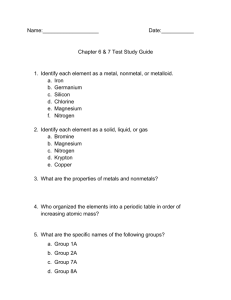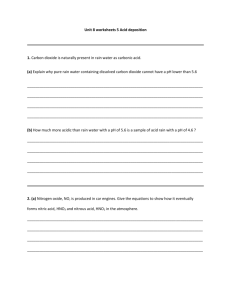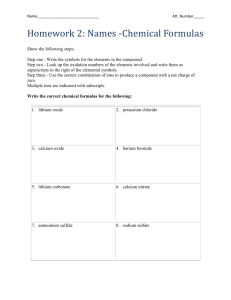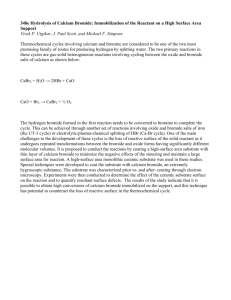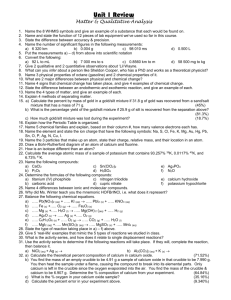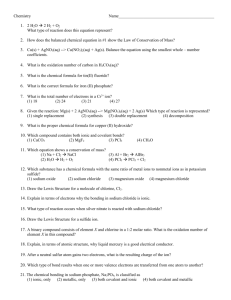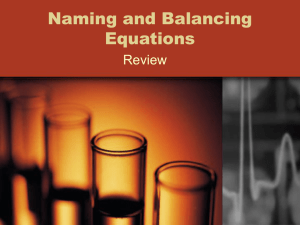photosynthesis chlorine
advertisement
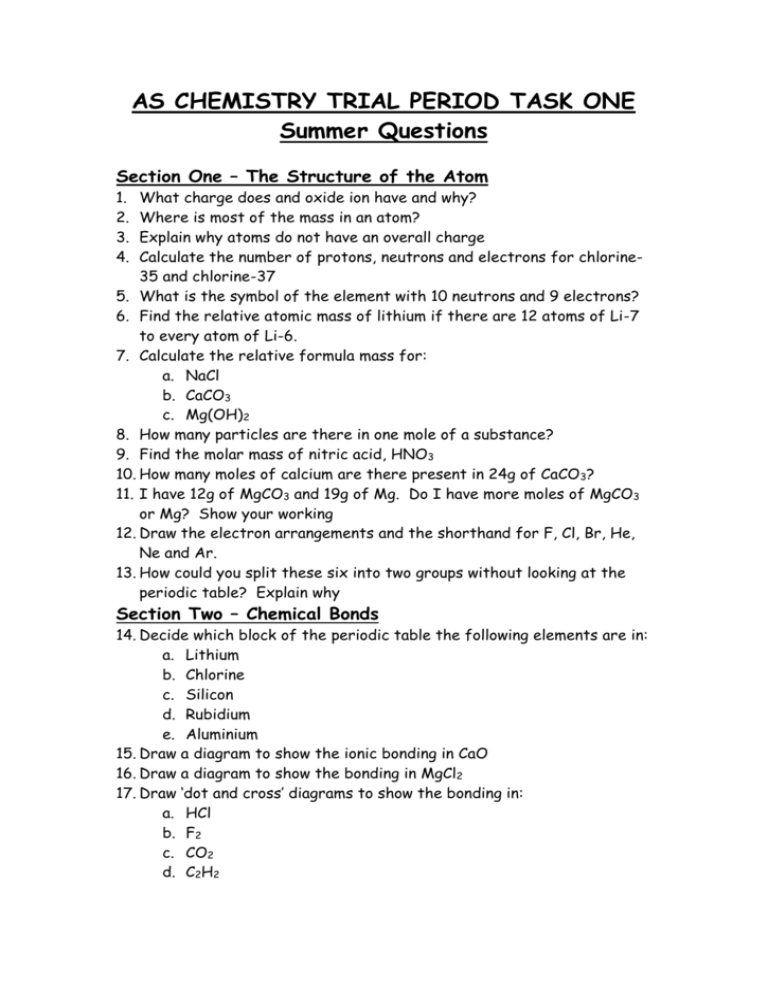
AS CHEMISTRY TRIAL PERIOD TASK ONE Summer Questions Section One – The Structure of the Atom 1. 2. 3. 4. What charge does and oxide ion have and why? Where is most of the mass in an atom? Explain why atoms do not have an overall charge Calculate the number of protons, neutrons and electrons for chlorine35 and chlorine-37 5. What is the symbol of the element with 10 neutrons and 9 electrons? 6. Find the relative atomic mass of lithium if there are 12 atoms of Li-7 to every atom of Li-6. 7. Calculate the relative formula mass for: a. NaCl b. CaCO3 c. Mg(OH)2 8. How many particles are there in one mole of a substance? 9. Find the molar mass of nitric acid, HNO3 10. How many moles of calcium are there present in 24g of CaCO3? 11. I have 12g of MgCO3 and 19g of Mg. Do I have more moles of MgCO3 or Mg? Show your working 12. Draw the electron arrangements and the shorthand for F, Cl, Br, He, Ne and Ar. 13. How could you split these six into two groups without looking at the periodic table? Explain why Section Two – Chemical Bonds 14. Decide which block of the periodic table the following elements are in: a. Lithium b. Chlorine c. Silicon d. Rubidium e. Aluminium 15. Draw a diagram to show the ionic bonding in CaO 16. Draw a diagram to show the bonding in MgCl2 17. Draw ‘dot and cross’ diagrams to show the bonding in: a. HCl b. F2 c. CO2 d. C2H2 Section 3 – Ionic and Covalent Structures 18. If an atom loses one electron what charge will it have? 19. If an atom gains two electrons what charge will it have? 20. In CaCO3 what is the ration of Ca2+ ions to CO32- ions? 21. In lithium oxide what is the ratio of Li+ ions to O2- ions? 22. Explain why ionic compounds do not conduct electricity when solid and what you can do to them to make them conduct. 23. Explain how ionic compounds dissolve in water in terms of charges 24. Describe the trend in boiling point of the alkanes as the carbon chain becomes longer 25. Explain why chloromethane has a greater boiling point than methane 26. Why are small covalent molecules insoluble in water and electrical insulators? 27. Compare the similarities and differences between graphite and diamond and link these to the different properties of each. 28. Explain the four trends across period 3 Section Four – Hydrocarbon Molecules 29. Why do the shorter hydrocarbon chains come off at the top? 30. What is the name of the process by which a mixture of hydrocarbons can be separated? 31. Write balanced symbol equations for the complete and incomplete combustion of: a. Propane (C3H8) b. Butane (C4H8) 32. Draw out the following alkanes: a. Octane (C8H18) b. Heptane (C7H16) 33. How could you distinguish between an alkene and an alkane? 34. Draw out all the possible structures for octene (C8H16) 35. Define the words monomer and polymer Section Five – Rates of Reaction 36. List three ways that you can measure the rate of reaction 37. List four ways that you can increase the rate of reaction 38. Explain what a dynamic equilibrium is 39. Explain what a catalyst is Section Six – Reversible Reactions 40. State Le Chatelier’s Principle N2(g) + 3H2(g) 2NH3(g) Exothermic 41. Copy out the above equation and balance it 42. What will happen to the yield of ammonia if you increase the pressure and explain why? 43. What will happen to the yield of ammonia if the temperature is decreased and explain why? 44. Why is a compromise of moderate temperature and pressure used? Section Seven – Symbol Equations 45. Deduce the formula of the following ionic compounds: a. Potassium chloride b. Calcium oxide c. Lithium oxide d. Calcium nitrate e. Iron(III)oxide 46. Balance the following symbol equations: a. ____ NaCl + ____ F2 ____ NaF + ____ Cl2 b. ____ H2 + ____ O2 ____ H2O c. ____ Pb(OH)2 + ____ HCl ____ H2O + ____ PbCl2 d. ____ AlBr3 + ____ K2SO4 ____ KBr + ____ Al2(SO4)3 e. ____ CH4 + ____ O2 ____ CO2 + ____ H2O Section Eight – Calculating Formulae 47. A compound consists of 29.1%Na, 40.5% S, and 30.4% O. Determine the simplest formula. 48. A compound is composed of 7.20 g carbon, 1.20 g hydrogen, and 9.60 g oxygen. Find the empirical formula for this compound 49. Calculate the molecular formula for the following: a. 64.9% C, 13.5% H and 21.6% O Mr = 74 b. 39.9% C, 6.7% H and 53.4% O Mr = 60 c. 40.3%, 52.2% H and 7.5% O Mr = 80 Section Nine – The Periodic Table 50. Find the symbols or names for the following: Helium, Hg, Magnesium, potassium, Ni, Cl, Ag 51. What is the charge on the ions formed by each of these elements: Li, calcium, Oxygen, Aluminium and F Section Ten – Reactivity and the Periodic Table 52. Explain what would happen if you mixed the following halogen and halide solutions and write an ionic equation for each reaction that occurs: a. Chlorine and bromide b. Bromine and chloride c. Iodine and bromide 53. Explain why the reactivity of group 2 metals increases down the group where as the reactivity of group 7 halogens decreases. Section Eleven – Chemical Reactions 54. Write down all the different types of reaction that each of the following could be classed as: a. Burning propane b. Chlorine + sodium bromide Sodium bromide + chlorine c. Calcium carbonate calcium oxide + carbon dioxide d. Hydrochloric acid + calcium carbonate Calcium chloride + water + carbon dioxide Section Twelve – Energy and Chemistry 55. Decide whether the following example are exothermic or endothermic and then explain why you made your choice: a. Hydrochloric acid and sodium hydroxide b. Burning Methane c. Photosynthesis d. Respiration e. Methane and steam 56. Calculate how much energy is released in the following reactions using bond energies. a. C3H6 + H2 C3H8 b. CH4 + 2O2 CO2 + 2H2O c. C6H14 + 9½O2 6CO2 + 7H2O Section Thirteen – How Science Works 57. Write definitions for the following key words when used in the context of investigations: a. Independent variable b. Dependent variable c. Control variable d. Mean result e. Anomalous result f. Valid g. Precise h. Accurate

